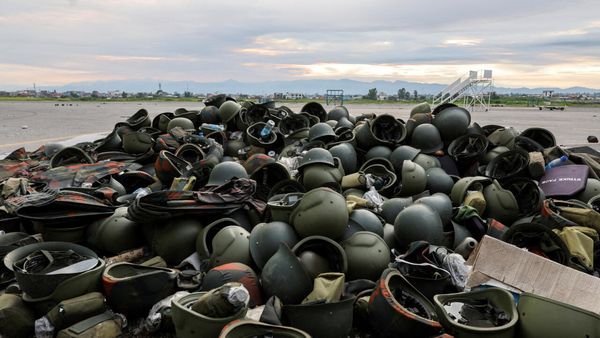The Department of Veterans Affairs is facing a nearly $15 billion combined budget shortfall this fiscal year and next, and congressional Republicans are crying foul at the last-minute notification about a funding crisis lawmakers have little time to try to fix.
VA officials told lawmakers on July 15 that the agency needs $2.9 billion in mandatory spending for veterans pensions and other benefits to cover a gap for the remaining months of the fiscal year ending Sept. 30. And they need another $12 billion in discretionary medical care funds for next year on top of what was provided in a March appropriations package or in the fiscal 2025 House and Senate Military Construction-VA bills.
The notification came after the House passed its fiscal 2025 Military Construction-VA bill on June 5, and after the Senate Appropriations Committee marked up its version on July 11.
If Congress does not act by Sept. 20, the VA estimates that 7 million veterans and their survivors may not receive their benefits payments on Oct. 1, according to Senate Veterans’ Affairs Committee ranking member Jerry Moran. Republicans in both chambers believe that the VA and White House Office of Management and Budget either should have seen this shortfall coming, or deliberately hid it from lawmakers.
“I think this is significant financial mismanagement, and/or incompetence at the Department of Veterans Affairs,” Moran, R-Kan., a senior Appropriations Committee member, said Thursday. “And I am gravely concerned that the administration, both the VA and OMB, specifically misled Congress for months about the state of affairs at the VA and the level of resources that are actually needed to care for veterans and their survivors.”
House Veterans’ Affairs Chairman Mike Bost, R-Ill., pushed the agency for answers about the shortfall in a July 17 letter, where he blamed the shortfall on a “troubling mix of anticipated costs that were not budgeted for and other costs that lack sufficient explanation or are speculative.”
Bost wrote that part of the shortfall consists of nearly $3.9 billion for pharmaceutical and prosthetics costs, including $1 billion to manage “chronic disease,” possibly related to obesity and the pricey weight loss drug Ozempic. He also suggested it was because of the VA’s rapid hiring, projected at 22,304 new full-time employees.
Record demand
According to agency officials, the crux of the issue is increased demand for health care services amid implementation of a 2022 law that expanded access for veterans exposed to burn pits and other toxins while serving in combat zones. Previously, veterans who got sick needed to prove their illnesses were directly tied to their military service; now, the presumption is such diseases are service-connected.
Over the last 365 days, 412,867 veterans have enrolled in VA care — a 27 percent increase compared to the previous year, VA press secretary Terrence Hayes said Thursday.
[Veterans toxic exposure bill clears Senate after tortuous path]
Still, Moran said there’s no reason why lawmakers couldn’t have been informed sooner. Before their fiscal 2025 markups began, Senate Appropriations Chair Patty Murray, D-Wash., and ranking member Susan Collins, R-Maine, reached a deal to allocate $34.5 billion in emergency spending on top of regular budget caps, and had they known about the VA shortfall, they could have factored it into their negotiations.
“Only after we did our work are we informed of this problem,” Moran said. “And it could not, in my view, been only then that VA or OMB knew these facts.”
The White House budget office referred questions to the VA.
The agency in its fiscal 2025 budget request assumed veterans health care accounts would dip heavily into unobligated balances to make ends meet, giving them room to request less overall in fiscal 2025 money than was appropriated for the previous fiscal year.
That freed up room for other domestic spending, while remaining within budget caps from last year’s debt ceiling agreement — something Collins and other top Republicans expressed concern about.
“We had raised questions about the over-reliance on unobligated carryover funds, and then we find that there is this enormous shortfall that could jeopardize benefits,” Collins said. “And that is just completely unacceptable. It’s hard for me to believe that this wasn’t concealed from us.”
VA Secretary Denis McDonough said during a Tuesday press conference that he has been clear to lawmakers that he would come back to Congress and ask for additional resources when they were needed.
“I kept saying we believe we have what we need, but if we need more, we’re going to come back and ask for it, because we want veterans to choose VA,” he said. “And at record levels, veterans are choosing VA.”
Veterans submitted 2.43 million claims applications in 2023, more than ever before and 39 percent higher than in 2022, according to the department.
Hayes, the VA spokesman, said the VA is delivering more care and benefits to veterans than ever, and the demand following the 2022 law has “exceeded even the most aggressive projections and expectations.”
“VA is working closely with Congress and the Office of Management and Budget to address these needs in a way that prevents any adverse impacts on veterans — and allow us to continue to deliver care and benefits to veterans at record rates,” Hayes said.
Band-Aid fix?
It’s not clear how lawmakers will move to address the shortfall. Senate Veterans’ Affairs Chairman Jon Tester, D-Mont., said the department may be able to get by using unobligated balances from this fiscal year.
“It will probably get fixed with carryover or appropriations. It could be taken care of with carryover, I haven’t seen the figures yet, I don’t know what kind of money they have left over,” said Tester, an embattled incumbent facing a tough reelection bid in a deep-red state.
While the nearly $3 billion in mandatory benefits funding could be included in the short-term stopgap measure that is expected to be needed to keep the government open after the end of September, it is unlikely that will be done by the VA’s Sept. 20 deadline to make millions of payments on time.
Regarding the $12 billion in fiscal 2025 health care funds, officials say if no additional funds are provided, the VA will make adjustments to live within the available budget while still providing quality care. But the agency has made clear receiving additional money would be preferable, and they aren’t detailing what sort of trade-offs would be necessary without it.
For her part, Collins said she had “no idea” how the shortfall will be addressed. And with this issue only emerging now, it could wind up in campaign talking points ahead of critical November elections to determine control of the White House, Senate and House.
The post Massive veterans budget gap rips hole in appropriations process appeared first on Roll Call.







